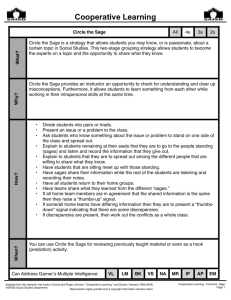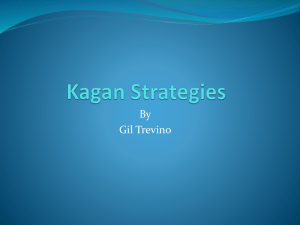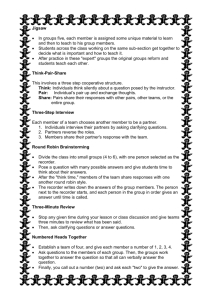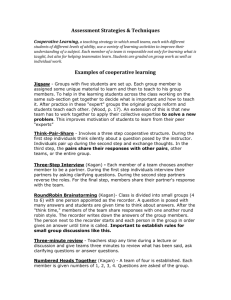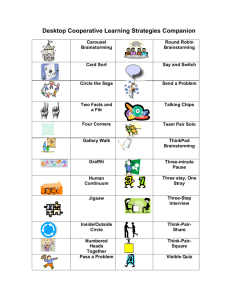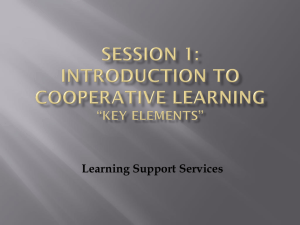Cooperative Learning
advertisement
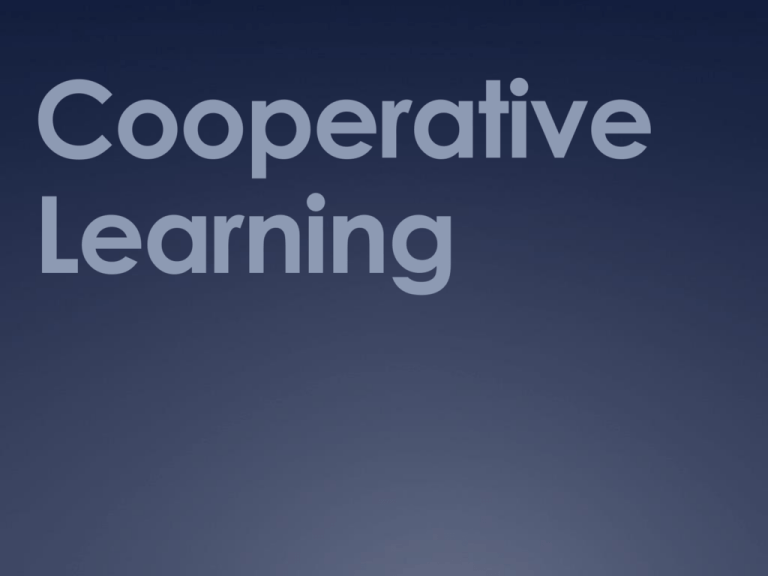
Cooperative Learning Why? Cooperative learning groups can: Promote student learning and achievement Increase students’ retention of knowledge Enhance students’ enjoyment of learning Help students develop oral language skills Help students develop social skills Promote student self-esteem Help promote positive race relations Cooperative learning is one step of the gradual release of responsibility model. 5 Elements of Cooperative Learning Positive Interdependence Face-to-Face Interaction Individual and Group Accountability Interpersonal and Small-Group Skills Group Processing Positive Interdependence Each group member’s effort is required for success. Each group member has a unique contribution or role to play within the group. Face-to-Face Interaction Students use their oral language skills to explain their thinking. Students teach each other. Check for understanding. Connect learning. Individual and Group Accountability Keep the size of the group small (4 people). Give an individual test to each student. Randomly call on students to present their group’s work. Observe how group members are contributing. Interpersonal & Small-Group Skills Social skills must be taught! Leadership Decision-making Trust-building Communication Conflict management Group Processing Group members discuss how well they are working together. Describe what behaviors are helpful and not helpful. Make decisions about what to change. Management Tip: Quiet Signal Students can SEE and HEAR it when interacting in groups. It is not overly annoying! Students know how to spread the quiet signal to others. Room should be quite within 3-5 seconds. Examples: Teacher raises hand and counts slowly from 5 to 0. If you can hear me, clap once, etc. Teacher uses a rain stick—when the beads are quiet, students should be quiet. Cooperative Learning Structures Jigsaw Team, Pair, Solo Think-Pair-Share Circle the Sage Three-Step Interview Value Line Round Robin Brainstorming Three-minute Review Numbered Heads Together Talking Chips Show Down Inside / Outside Circle Jigsaw Students are placed into expert groups. In these groups, they are assigned a specific section of text or a specific piece of material to learn. After the expert groups have met and feel comfortable with the material, new groups are formed with one member from each expert group. In the new groups, each member teaches the rest of the group the assigned material. Think-Pair-Share First, students think silently about a question posed by the teacher. Second, students pair up and exchange ideas. Third, the pairs form groups and share. Three-Step Interview Each member of a team of 4 chooses another member to be a partner. Individuals interview their partners by asking clarifying questions. Then, the partners switch roles. Finally, individuals share their partner’s response with the team. Round Robin Brainstorming In small groups of 4, one person is appointed a recorder. The teacher asks a question that has many different possible answers. First, students are given time to think. After think time, students share their responses with the group, round robin style. The recorder writes the answers of each group member. Three-Minute Review Teachers stop anytime during a mini-lesson or discussion and give teams three minutes to review the material. Students may ask each other questions, clarify information, etc. Numbered Heads Together In a team of four, each member is give a number (1, 2, 3, or 4). The teacher asks a question. The group discusses the answer. Then, the teacher calls out a number and each person with that number is asked to give the answer. Team, Pair, Solo Students work out a problem as a team, first. Then, students work with a partner. Finally, students complete the problem independently. Circle the Sage The teacher identifies 4-5 students who understand a concept in-depth (the sages). These students spread out across the room. Team members go to different groups. In the group, the sage explains the concept or material. Students can ask questions, take notes, etc. Members of the groups report back together to share what they learned from their sage. Value Line The teacher makes a statement. Students stand on an imaginary line across the room from strongest agree to strongest disagree. Students line up without talking. Students discuss their view with other students sharing a similar perspective (those standing near them). The line is folded and then they talk with a partner about their differing views. Talking Chips Each student in a group receives one talking chip. Students place their chip in the center of the team table each time they talk. Students may speak in any order, but cannot speak a second time until all the chips are in the center. Students re-distribute the chips and continue. Show Down The teacher reads a question. Students write their answer on a white board, covering their answer. Teacher announces, “Show Down!” Students compare answers in their groups and make sure everyone in the group has the right answer. Inside / Outside Circle Students stand in two circles. The inside circle faces out, and the outside circle faces in. Students have a partner. The teacher asks a question. The partners discuss. If there is a right answer for the question, pairs need to make sure they know the answer. If they are stuck, they may consult with pairs on either side of them. The teacher may ask for a choral response or call on an individual. References Work by Spencer Kagan: www.kaganonline.com http://edtech.kennesaw.edu/intech/cooperativ elearning.htm Kagan powerpoint: kagan-ppt-013008- 1231382601240090-2.ppt
